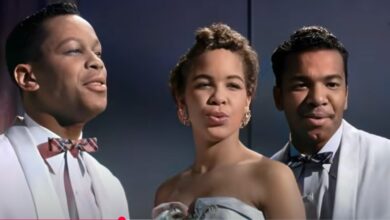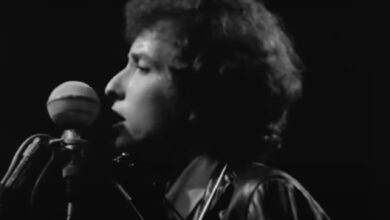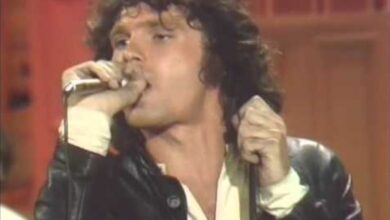Ricky Nelson’s “Hello Mary Lou” Captures the Spirit of Early Rock and Roll in 1961
In 1961, “Hello Mary Lou” by Ricky Nelson arrived like a burst of sunshine on the rock and roll landscape. Released as the B-side to Nelson’s chart-topping single “Travelin’ Man”, the song swiftly carved out its own legacy. With its infectious melody and heartfelt lyrics, “Hello Mary Lou” exemplified the carefree charm of early ’60s pop. Its lasting popularity would ultimately overshadow many other tracks of its era, securing its place as one of Nelson’s most iconic recordings.
Born Eric Hilliard Nelson in 1940, Ricky Nelson grew up surrounded by the bright lights of Hollywood. As the son of Ozzie and Harriet Nelson, stars of the popular sitcom The Adventures of Ozzie and Harriet, he was introduced to the entertainment world at a young age. But despite his Hollywood upbringing, Nelson’s true passion was music. By the late 1950s, he had emerged as a teen idol, bridging the gap between wholesome television star and authentic rock and roll performer. His natural charisma and smooth, emotive voice made him a standout figure in the rapidly evolving music scene.
The origins of “Hello Mary Lou” trace back to Gene Pitney, who penned the upbeat tune. Pitney’s talent for crafting relatable stories of youthful romance came through in the song’s lyrics, capturing the rush of infatuation in just a few lines. With its simple but effective narrative, “Hello Mary Lou” resonated with the hearts of listeners, particularly young fans who saw their own experiences reflected in the song. Legendary guitarist James Burton further elevated the track with his now-iconic rockabilly guitar solo, adding a level of authenticity that would set the song apart.
The recording session for “Hello Mary Lou” took place in Hollywood under the direction of producer Jimmie Haskell. With Burton’s signature twang on lead guitar, Joe Osborn on bass, and Ritchie Frost on drums, the sound was unmistakably energetic. Nelson’s warm vocals glided over the instrumentation, giving the track a polished yet spontaneous feel. The recording’s seamless blend of rockabilly, country, and pop created a timeless sound that resonated across genres.
While “Travelin’ Man” quickly rose to number one on the Billboard Hot 100, “Hello Mary Lou” became a hit in its own right, peaking within the top ten. Internationally, the song found particular success in the UK, where it climbed the charts and became a staple of the rock and roll era. Its enduring popularity has been fueled by its frequent inclusion in films, television shows, and nostalgic compilations, ensuring new generations continue to discover its charm.
More than just a chart success, “Hello Mary Lou” became a cultural touchstone. The song’s breezy, lighthearted tone captured the carefree spirit of early ’60s America, a period marked by optimism and youthful exuberance. It was a reminder of the power of simple storytelling, where a few heartfelt words and a memorable melody could resonate deeply. Nelson’s relatable persona only amplified this effect, positioning him as a figure who personified the innocence and charm of the era.
For Ricky Nelson, the success of “Hello Mary Lou” further cemented his reputation as a credible rock and roll artist. No longer just a television star dabbling in music, he proved his ability to deliver genuine, radio-friendly hits. The song opened doors for Nelson to tour internationally, broadening his fan base and reinforcing his influence on the global stage. It also showcased his knack for selecting songs that suited his vocal style, a quality that would continue to serve him well throughout his career.
The track’s lasting influence extended beyond Nelson’s own career. Many artists have covered “Hello Mary Lou” over the years, each adding their unique twist. Creedence Clearwater Revival’s live rendition introduced the song to rock audiences in the 1970s, while country legends like Emmylou Harris offered a heartfelt reinterpretation. The song’s adaptability across genres spoke to its universal appeal and the strength of Pitney’s songwriting.
Behind the scenes, Nelson’s dedication to authentic musicianship left a lasting impact on his peers. His collaboration with James Burton, in particular, is often cited as a pivotal moment in rockabilly history. Burton’s distinctive guitar style, characterized by quick picking and vibrant twang, would go on to influence countless guitarists, including Elvis Presley, who later enlisted Burton as a member of his famed TCB Band.
Although “Hello Mary Lou” was released during a time of personal and professional growth for Nelson, it also marked a bittersweet moment. As the early ’60s gave way to the British Invasion, the music landscape began to shift. Yet Nelson remained a beloved figure, and “Hello Mary Lou” stood as a reminder of the era’s simpler, more innocent sound. Even as musical trends evolved, the song’s appeal endured, maintaining its place on classic rock and oldies radio stations.
Reflecting on its legacy, “Hello Mary Lou” is more than just a song of romantic admiration — it’s a testament to the lasting power of early rock and roll. It captures a moment in time when music was joyous, melodic, and free-spirited. For Ricky Nelson, it represented the essence of his artistry — a genuine connection with his audience through music that was both heartfelt and timeless.
Decades after its release, “Hello Mary Lou” continues to evoke a sense of nostalgia and joy. Whether it’s the twang of James Burton’s guitar, the sincerity in Nelson’s voice, or the song’s infectious chorus, its enduring charm remains unmistakable. As listeners hum along to its familiar melody, they are reminded of why Ricky Nelson will always be remembered as one of rock and roll’s most cherished voices.



